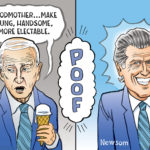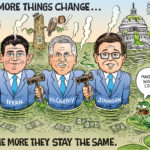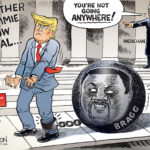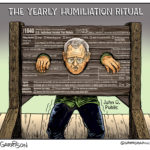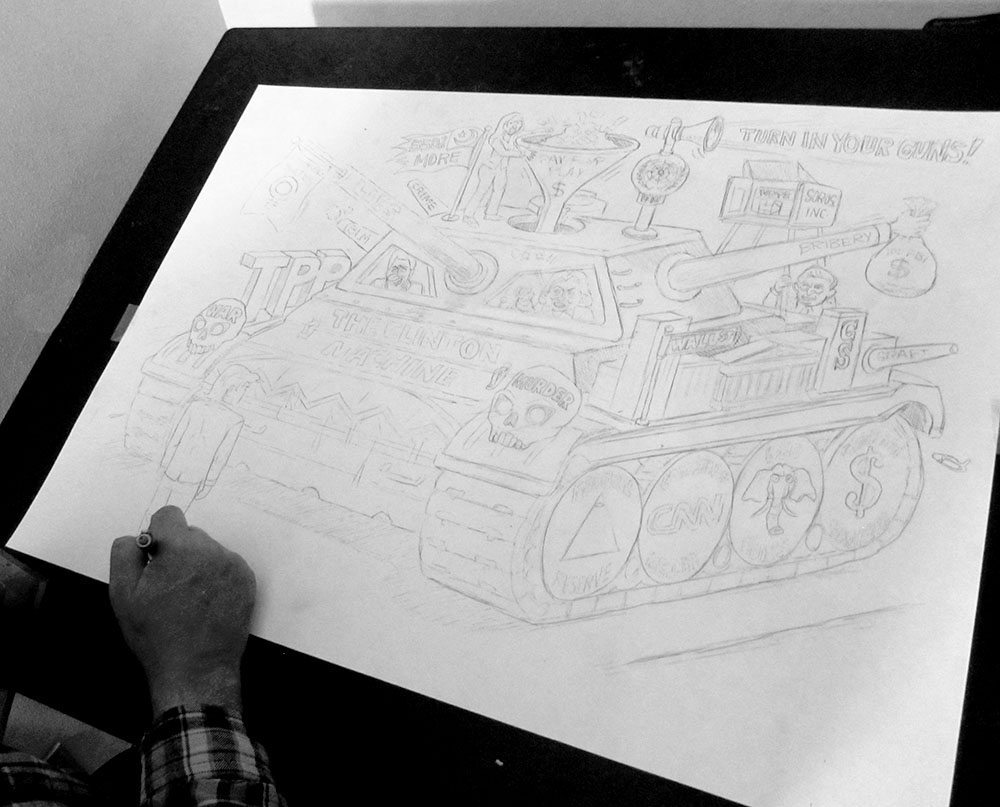
Advice for Aspiring Cartoonists
Let me preface this by reminding everyone that we are in the midst of a sea change in editorial cartooning. During the golden age of newspapers, there were nearly 2,000 cartoonists employed at newspapers across the country and some of them were paid exceptionally well. Many were superstars of their day. They enjoyed a wide audience since radio and TV didn’t yet exist.
Now there are only around 30 paid editorial cartoonists remaining at the major metros in this country and that number continues to dwindle as circulation declines. Newspapers are dinosaurs and only a step away from stumbling into their inky graves.
Some might say that editorial cartoons have lost their relevance during this great transitional upheaval. I disagree. We now have the Internet and that means any cartoonist can have a voice. It may be difficult to hear that voice at first due to the massive visual noise that accompanies the Web, but at least the cartoonist no longer must deal with hectoring editorial page editors and daily deadlines. The Internet is always there and the cartoonist can produce work whenever it aligns to his schedule.
Today’s Internet cartoonist has complete freedom and their work can potentially reach well beyond one city. It can be seen around the world in an instant. I recently drew a cartoon that garnered 500,000 views in one day. That’s as much or more than many major metros, and the cartoons have more staying power, while cartoons in newspapers are seen for only a day or so. Then the paper becomes so much fish wrap. Those cartoons are soon forgotten until the artist comes up with a book collection or ‘best of’ page to be run just before a new year.
The more popular cartoons could possibly appear in history books or ‘best of’ cartooning books, but the mass audience will have long since departed. Again, as a potential cartoonist, you have a great opportunity by self-publishing on the Internet.
Opportunities are not without risk. Here’s what you may face if you decide to get serious about producing political cartoons and publishing them on the Internet:
- If you’re not well known, you will most likely have to deal with trolls.
Especially if your cartoons are seen as being effective. If your work is over the target, you’ll catch flak. I’m not talking about mail from people telling you how your cartoon failed for various reasons. That comes with the territory. I’m referring to the anonymous trolls who will ignore your copyright and change your work into racist or anti-Semitic hatred–and they make sure they leave your name on it. They will encourage troll armies to go after you if you complain. You will be swamped by hate mail. If you are employed, they will go after your employer and try to get you fired. They will harass friends, family and landlords if they can. The trolls cannot stand someone getting some limelight and will try to smear you because you got ‘uppity.’ They are losers and can’t stand to see others succeed. There’s not much you can do about the trolling, either. The only solution I found was to outshout and outpost them. It took a lot of work on social media for me to regain my own voice. If possible, it’s best to be self-employed before you start drawing political cartoons. If you want to avoid such harassment altogether, then you might want to consider drawing them anonymously. There aren’t many female editorial cartoonists and those currently penning them are nearly all ‘progressives.’ If you’re a woman cartoonist and conservative, you will quickly gain popularity because you will be quite a rarity, but you will probably also face an avalanche of trolling—especially from the SJW crowd. - Follow your own vision.
Observe what other cartoonists are doing, but draw in whatever style feels most comfortable for you. It could be done completely digitally. Maybe it’s vector art or done in Photoshop. For me, I like the old-fashioned approach of India ink on illustration paper. Rather than copy another cartoonist’s style I recommend you become who you are. It’s more interesting to hike on your own trail. - The idea for the cartoon is, of course, of paramount importance.
How do you come up with them? Just the fact that you want to draw editorial cartoons means you must have an opinion. You probably follow the news and do a lot of reading. If you’re a bland centrist and don’t want to hurt anyone’s feelings, you should consider sticking to some other endeavor. The best ideas come like a bolt from the blue. Others require a lot of thought and tinkering to make them work. I suggest you start with recognizable metaphors that are easy for readers to figure out at a glance. There are plenty of analogies, clichés and idioms, and your job is to make them compelling and fresh. For example, the Pied Piper has been drawn by countless times. So has Pinocchio—his nose is a symbol of lying. If you can make those come across as original and fresh ideas, then that’s fine, but there are endless possibilities and other combinations out there waiting to be penned. - Every artist, musician and writer faces something I call ‘inertia.’
Inertia consists of whatever keeps you from realizing your artistic goal. Inertia keeps you from drawing, practicing or writing. Inertia is insidious and it will do whatever it can to stop you from doing what you really want to do in life. It’s negative thinking at its finest. It will tell you there’s plenty of time—do it tomorrow. No. Do it now! Inertia exists in your own brain and it will invent endless reasons to stop you. Friends, family and complete strangers who don’t like your work might also tell you you’re wasting your time. That feeds the inertia and stops you from getting better. I’ve had people tell me to my face that I’m a crummy artist. Some have even tried to get me fired. But all too often the cruelest critic is the one inside you. It’s the internal critic and he doesn’t want you to succeed. He will fill your head with negativity and despair. This is a very bad situation for artists because when our life’s dream is on the ropes we want to escape and that usually means booze or whatever other destructive means necessary to blot out the quandary. I’m here to tell you there are ways to deal with that cul-de-sac. It requires a change in thinking. I explain that next. - Why do you want to be an artist?
More specifically, why do you want to become an editorial cartoonist? Fame and popularity? Wrong answer. Money? Wrong answer. To win a Pulitzer Prize and awards to prove your worthiness? Wrong answer. Email applause from strangers? Wrong answer. The correct answer is this: You see wrongs and corruption being committed and you see it as your civic duty to raise public awareness to right those wrongs. But first, you must accept yourself for who you are. Be grateful for the talent you have. Stop comparing yourself with others. There will always be someone better. You’re not a genius and you’ll never be the best as judged by others. Even if you are for a time, it’s fleeting. So be happy with what you can do and also be happy that you have a sound mind that can figure out right and wrong. And if you find yourself mistaken and in the wrong, apologize and move on to what’s right. It’s OK to change your position on things in the face of reason, evidence and logic. Try to remain humble. I’ve known quite a few paid political cartoonists and they never got better because they believed it when everyone told them they were great. Since they thought they had already arrived, there was no reason for them to further their skills. Additionally, most cartoonists adhere to the progressive, socialist agenda. They draw cartoons that are pro-big government and taxes. They want guns taken away. They serve the Illuminati system. Their ideas mostly consist of ad hominem and straw man attacks. A weak idea is not saved much by great drawing. A great idea will still work even if the drawing could be better. Regardless, that pesky old inertia may tell you to give up because everything has already been done before. That’s an insidious lie. There are endless possibilities. Even if it has been done before, it has yet to be done by YOU. When you’re doing any kind of artwork, whether it be painting or cartooning, maintain a positive attitude while doing it. The great German amateur painter, Bill Alexander, recommended this highly. He was the original happy painter before Bob Ross came along and stole his show. There’s always time after you’re finished to critique your results, but while drawing make sure you maintain a confident and happy attitude. After all, editorial cartooning can also be fun! Art, music and writing are fun. Even without fame, fortune and awards, we will be doing them regardless. That’s the mindset I recommend. - Special advice to young people: Editorial cartooning is in a flux.
Forget about getting a well-paid job at a newspaper. Those jobs have always been very difficult to get. That’s why the cartoonists who got them stayed with it until they got old and retired. When they retire, they’re not being replaced. Messy and expensive newsprint is rapidly becoming a thing of the past. The trouble is, it’s extremely difficult to make a living as a cartoonist on the Internet. I’m trying, but I’m not there yet. So it’s better for you to have another job until you can gain traction. I also realize that your generation grew up with video games. That habit sets up expectations that problems can be quickly solved and you can easily move up to higher levels. That’s not how life works. Even if you get up to higher levels, life can easily knock you down back to the beginning. We need new cartoonists who have a fresh perspective and understanding of new and changing realities. Good luck and happy cartooning!
—Ben Garrison


